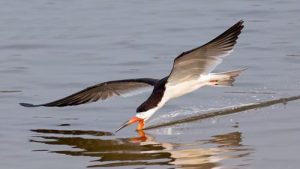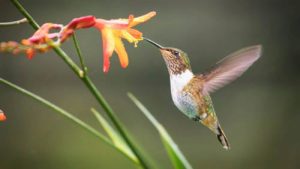Is Climate Change Changing the Birds We See?
Breaking news! A bird you have never seen or heard before is going extinct in a remote part of the world! While I am sure we can all agree that it is terrible for these birds, we can still enjoy the beauty of our most beloved backyard and local birds without experiencing the loss of those more exotic ones. Nevertheless, I hate to be the bearer of bad news. Climate change is a threat to all species, whether or not we can directly see its impacts.
 Think of a relaxing day on the beach, watching Piping Plovers and Sanderling frolic along the sand. Or perhaps on vacation watching those darling Atlantic Puffins on the rocks seen from a tour boat. Things look OK, right? However, as the ocean warms, the fish these cuties rely on migrate away as waters warm and their food source, plankton, dies. The ripple effect causes puffins to be unable to feed either themselves or their chicks. And those shorebirds on the sand? The small mollusks they eat are increasingly harmed by ocean acidification.
Think of a relaxing day on the beach, watching Piping Plovers and Sanderling frolic along the sand. Or perhaps on vacation watching those darling Atlantic Puffins on the rocks seen from a tour boat. Things look OK, right? However, as the ocean warms, the fish these cuties rely on migrate away as waters warm and their food source, plankton, dies. The ripple effect causes puffins to be unable to feed either themselves or their chicks. And those shorebirds on the sand? The small mollusks they eat are increasingly harmed by ocean acidification.
 Piping Plovers and Sanderling that migrate as far as Newfoundland and the Arctic find their nesting areas and food sources there reduced because of climate change. Meanwhile, as sea levels rise along the East Coast, beachfront continues to disappear, destroying the habitat and nesting areas for other beauties like the Black Skimmer, one of Rachel Carson’s favorites, that is increasingly endangered since it nests on beaches and small barrier islands, like North Carolina’s Outer Banks, that are being flooded and submerged.
Piping Plovers and Sanderling that migrate as far as Newfoundland and the Arctic find their nesting areas and food sources there reduced because of climate change. Meanwhile, as sea levels rise along the East Coast, beachfront continues to disappear, destroying the habitat and nesting areas for other beauties like the Black Skimmer, one of Rachel Carson’s favorites, that is increasingly endangered since it nests on beaches and small barrier islands, like North Carolina’s Outer Banks, that are being flooded and submerged.
My love for birds began by watching hummingbirds fly to my grandmother’s feeders and I am sure many others hold the same fondness for them. As summer days get hotter, they spend more time searching for shade and rest and less time socializing and reproducing. Hotter nights also limit the amount of energy they can save for the next day. Hummingbirds play an important role as pollinators, so their decline hurts more than just our enjoyment. Flowers are now blooming earlier and often before hummingbirds make their return trip home causing hummingbirds to lose a majority of their critical food source.
Birders and ordinary citizens celebrate migration seasons every year, enjoying birds that pass through or return to their yards from vast distances, experiencing and enjoying new plumages and calls they do not get to hear every day. Nevertheless, NOAA researchers have been collecting data on bird migration for decades and have found that changes in temperatures across the world are changing, and so are migration patterns. Birds may migrate at the wrong time, or end up in the wrong place.
While all this may seem depressing, there are things we can do to help mitigate these effects. NOAA migration data can also help in the restoration and protection of vital habitats and show where to provide food sources birds rely on. We can promote “natural infrastructure” on the coasts, which can provide habitats and protection for seabirds. We can lobby our senators and local governments, demanding action on fossil fuel emissions and better protection for our marine areas and seabirds to ensure their survival.
Whether someone considers themselves a birder or not, we all have our favorite bird that we get excited to see. It may be the Robin, or Blue Jay, or a tiny hummingbird. Everyone knows the feeling of seeing that bird for the first time in the spring. But even the familiar, beloved backyard Robin is just one of the species that has begun to migrate earlier each year, 12 days earlier than in 1994, as their environmental cues to leave change.
We need to be more cognizant of our avian friends, whether in the backyard or beyond. Put out plenty of food for migrating birds to ensure that even if they are off on time or route, they can still receive the nutrients they need. Then, we can all do our part to help mitigate the effects of climate change and protect our birds. Call your elected representatives and urge them to support bird conservation bills such as the Neotropical Migratory Bird Conservation Act and the Migratory Birds of the Americas Conservation Enhancements Act. Finally, take time a little time each day to watch the birds and appreciate the privilege of witnessing their beauty.
— Maggie Dees
 RCC Stanback Presidential Fellow – Maggie Dees
RCC Stanback Presidential Fellow – Maggie Dees
Maggie Dees co-leads the RCC Bird Watch and Wonder program. She is a sophomore in the honors program at Virginia Tech University majoring in environmental science. She is from Salisbury, NC, and is passionate about environmental justice and conservation.
![]() The Rachel Carson Council depends on tax-deductible gifts from concerned individuals like you. Please help if you can.
The Rachel Carson Council depends on tax-deductible gifts from concerned individuals like you. Please help if you can.
![]() Sign up here to receive the RCC E-News and other RCC newsletters, information and alerts.
Sign up here to receive the RCC E-News and other RCC newsletters, information and alerts.


